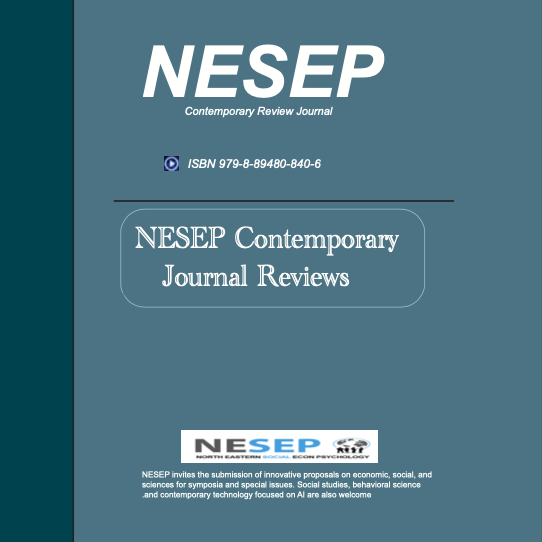Accepted Articles
We congratulate you on acceptance of your manuscript.

Annual Expo by the Journal of Young Explorers Meta and NESEP
- Fundamental or applied research
- Interdisciplinary research
- Judging on a rolling basis
- A work-in-progress research
- Completed research
- Unlimited topics and ideas
- ISBN 979-8-89480-840-6
- NESEP/NY-CSEF event at Harvard Club in NYC
Genetic Stability at Risk: Mutations from GMOs and Environmental DNA Oxidation by Biphenyl and BPDE
Abstract: In modern environmental and biological research, gene mutation by GMOs and DNA oxidation by biphenyl and BPDE intercalation take up critical positions regarding their potential risks to genetic stability. GMOs are monitored for unintended effects, and BPDE pollution is managed due to their carcinogenic potential. Genetic modifications in GMOs are made through precise gene edits, often using techniques like CRISPR-Cas9, to minimize unintended effects. However, off-target mutations or horizontal gene transfer could affect neighboring genes or regulatory sequences. Although GMOs undergo rigorous testing, ongoing research examines the long-term effects of gene edits on genome stability.
This paper investigated DNA Oxidation from Biphenyl and BPDE that arises from environmental pollutants. BPDE, a metabolite of the carcinogen benzo[a]pyrene found in tobacco smoke, intercalates with DNA, disrupting its helical structure and creating oxidative stress. If left unrepaired, this intercalation can produce reactive oxygen species (ROS), leading to strand breaks, nucleotide mispairing, and permanent mutations. We also checked and evaluated the mutations linked to cancer risk, especially in lung, liver, and skin cancers, as they can affect critical genes controlling cell growth and apoptosis.
This research studied both GMO-related and environmental mutagenic effects that underscore the need for vigilance in evaluating genetic stability.
Keywords: GMO, DNA oxidation, adduct intercalation, mutations, genetic stability
References
-
Heal, G. (2009). Climate economics: A meta-review and some suggestions for future research. Review of Environmental Economics and Policy, 3(1), 4–21. DOI: 10.1093/reep/ren003
-
Jaffe, A. B., Newell, R. G., & Stavins, R. N. (2005). A tale of two market failures: Technology and environmental policy. Ecological Economics, 54(2-3), 164–174. DOI: 10.1016/j.ecolecon.2004.12.027
-
World Economic Forum. (2020). The Global Risks Report 2020. World Economic Forum. DOI: 10.23943/Princeton/9780691201009.001.0001
-
Dasgupta, P. (2001). Human Well-being and the Natural Environment. Oxford University Press.
-
Daly, H. E. (1996). Beyond Growth: The Economics of Sustainable Development. Beacon Press.
-
Barbier, E. B. (2007). Natural Resources and Economic Development. Cambridge University Press.
-
Goulder, L. H., & Schneider, S. H. (1999). Induced technological change and the attractiveness of CO2 emissions abatement. Resource and Energy Economics, 21(3-4), 211–253. DOI: 10.1016/S0928-7655(99)00009-3
-
Stern, D. I. (2004). The rise and fall of the environmental Kuznets curve. World Development, 32(8), 1419–1439. DOI: 10.1016/j.worlddev.2004.03.004
-
International Energy Agency. (2019). World Energy Outlook 2019. OECD/IEA. DOI: 10.1787/weo-2019-en
-
Acemoglu, D., Aghion, P., Bursztyn, L., & Hemous, D. (2012). The environment and directed technical change. American Economic Review, 102(1), 131–166. DOI: 10.1257/aer.102.1.131
-
Grossman, G. M., & Krueger, A. B. (1991). Environmental impacts of a North American free trade agreement. National Bureau of Economic Research. DOI: 10.3386/w3914
-
United Nations. (2015). Transforming our world: The 2030 Agenda for Sustainable Development. UN General Assembly. DOI: 10.1002/9781118391300
-
Neumayer, E. (2003). Weak versus strong sustainability: Exploring the limits of two opposing paradigms. Edward Elgar Publishing.
-
Piketty, T. (2014). Capital in the Twenty-First Century. Harvard University Press.
-
United Nations Development Programme. (2019). Human Development Report 2019: Beyond income, beyond averages, beyond today - Inequalities in human development in the 21st century. UNDP. DOI: 10.18356/78b829e1-en
-
World Bank. (2016). State and Trends of Carbon Pricing 2016. World Bank Group. DOI: 10.1596/978-1-4648-0758-6
-
Romer, P. M. (1990). Endogenous technological change. Journal of Political Economy, 98(5), S71–S102. DOI: 10.1086/261725
-
Nordhaus, W. D. (2007). A review of the Stern Review on the economics of climate change. Journal of Economic Literature, 45(3), 686–702. DOI: 10.1257/jel.45.3.686